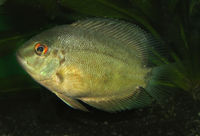Uaru (Uaru amphiacanthoides)
From The Aquarium Wiki
(Redirected from Uaru)
Uaru
Uaru amphiacanthoides
246 Litres (65 US G.)
20.3-25.4cm (8-10 ")
Freshwater
5.0 - 7.0
26 -28 °C (78.8-82.4°F)
5-12 °d
1:1 M:F
8-12 years
Family
Cichlidae
Contents
Additional names
- Triangle Cichlid, Triangular Cichlid, Waroo
Additional scientific names
- Acara imperialis, Pomotis fasciatus, Uaru obscurum
Origin[edit]
- South America: Amazon River basin, along the Amazon-Solimões River drainage from the Japurá River to the Tapajós River, and in the middle and lower Negro River basin.
Sexing[edit]
- Cannot be sexed outside of spawning. During spawning the genital papilla is visible, pointed in the male and blunt and rounded in the female. They will lay eggs on a flat stone in low illuminated places in the tank.
Tank compatibility[edit]
- A peaceful Cichlid that should be kept in groups of 4-5 or more, keep more females to males. Will co-habit with equally peaceful Cichlids, such as Angelfish and Discus, and other fish but avoid keeping them with very small fish or larger aggressive fish.
Diet[edit]
- Will accept most foods including Cichlid pellets, bloodworms, daphnia, tubifex and vegetable matter.
Feeding regime[edit]
- Feed once or twice a day.
Environment specifics[edit]
- Provide this fish with a well matured spacious tank with a gravel substrate and plenty of rocky caves. They prefer unplanted as they will eat live plants, but should have dim lighting to make up for this. Sensitive for bad water quality, such as NO2 and NO3. Needs regular water changes.
Behaviour[edit]
- A peaceful Cichlid that appreciates company of its own kind.
Identification[edit]
- A rounded oval-cichlid with pointed anal and dorsal fins, rounded caudal fin and large round eyes. The fins are mostly translucent while the body is a cream-yellow to grey-silver in colour with a broad black irregular horizontal band from the gill plates to the caudal peduncle. Above this black marking is a slender dotted line.
Pictures[edit]
External links[edit]
- Fishbase (Mirrors:
 )
)
